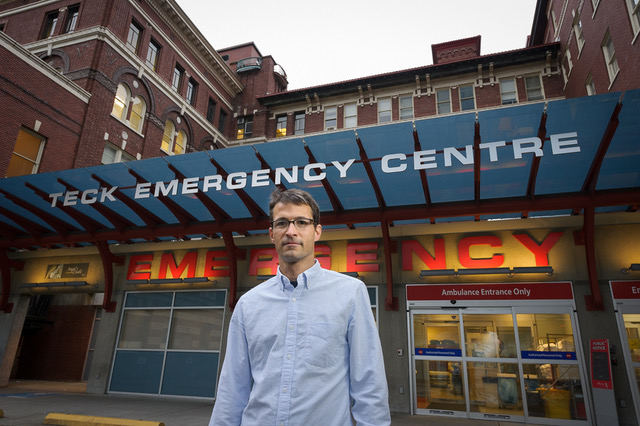Every day in emergency departments across the province, someone who uses opioids is discharged without ever being offered treatment or care. As a result, the risk of a fatal overdose increases the moment that person walks out those hospital doors, the opportunity to connect them with evidence-based care is gone.
The Learning about Opioid Use Disorder (LOUD) in the ED initiative aims to change that by providing accessible training and resources to improve how substance use care is delivered in emergency departments (EDs). For Dr. Andrew Kestler, targeting clinicians working in EDs is a no-brainer.
“Over 50 per cent of people who experience fatal overdose have presented to an emergency department within the last year,” says Dr. Kestler, who’s an emergency physician based at St. Paul’s Hospital in Vancouver. “We know that the highest risk people, who end up dying, are in fact passing through the emergency department at some point.”
Stigma prevents many from seeking support
Dr. Kestler is one of the lead faculty members for LOUD in the ED, which is a partnership between the BC Centre on Substance Use (BCCSU), BC Patient Safety & Quality Council, and Overdose Emergency Centre. The initiative started as a quality improvement collaboration involving emergency departments around BC. Based on participant feedback, the initiative is now concluding with interactive webinars geared towards improving care for people with opioid use disorder (OUD) in EDs.
The focus on emergency care for people with OUD is crucial when considering how patient healthcare needs are not being met before being discharged from the hospital. Emergency rooms are open 24/7, which offers flexibility to individuals who may struggle to keep appointments, and who may be at increased risk due to challenges with their mental health, financial, or housing situation compounded with opioid use. Additionally, stigma around substance use prevents many individuals from seeking support. As a result, emergency settings may be the only point of contact with medical professionals for many. Yet, far too often that point of contact represents a missed opportunity.
“Historically, we went from a period where the encounter between an emergency provider and a patient could be frustrating on both ends,“ Dr. Kestler says. “The patient felt like they couldn’t get any help and the provider was frustrated feeling nothing they could do in an emergency setting to address the underlying issue. I believe we’re shifting towards feeling like there’s more options available now.”
LOUD initiative hopes to fill in the gaps
Dr. Kestler believes EDs provide a unique opportunity to connect with patients and provide clinical interventions for substance use disorders. If the gaps in health systems and training in addictions care can be pivoted to reflect pathways created for other health issues.
“For diseases that are not stigmatized, there is a smooth process where it’s understood that emergency care goes beyond treating the acute condition,” he explains. “The ED would be expected to organize further evaluation, follow ups, and connection to other supports to make sure a major disaster down the road is averted.”
The goal of LOUD in the ED is to fill in these gaps in addiction care training and in addiction care delivery in emergency settings, by creating standardized steps for OUD care.
“Not having protocolized care across the province takes time and capacity away from emergency departments and staff, and ultimately from the patients,” Dr. Kestler explains.
“We’ve got a long way to go”
The LOUD in the ED webinar series continues through March 2022. Clinicians are encouraged to join any time, with resources available to support their learning regardless of when and where they start.
Dr. Kestler hopes that in the future there will be opportunities for another learning collaborative to initiate the next steps of implementing programs in addiction care for emergency settings across BC.
“We’ve seen a lot of change in the last few years, but we’ve got a long way to go in implementing addiction medicine into standard emergency care. We really need to jump on every opportunity to get these individuals empowered with options and into robust community care.”
Learn more about LOUD in the ED here: Opioid Use Disorder Care In The Emergency Department
This story originally appeared on the BCCSU website.





